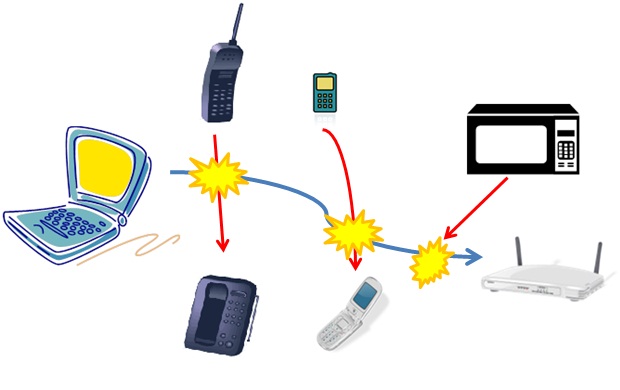
Cross-technology interference is emerging as a major problem for 802.11 networks. Independent studies in 2010 by the Farpoint Group, BandSpeed, and Miercom all show that highpower interferers like baby monitors and cordless phones can cause 802.11n networks to experience a complete loss of connectivity. Other studies from Ofcom, Jupiter Research, and Cisco report that such interferers are responsible for more than half of the problems reported in customer networks. Today’s high-power non WiFi sources in the ISM band include surveillance cameras, baby monitors, microwave ovens, digital and analog cordless phones, and outdoor microwave links. Some of these technologies transmit in a frequency band as wide as 802.11, and all of them emit power that is comparable or higher than 802.11 devices. Further, the number and diversity of such interferers is likely to increase over time due to the proliferation of new technologies in the ISM band.
Traditional solutions that increase resilience to interference by making 802.11 fall down to a lower bit rate are ineffective against high-power cross-technology interference. As a result, the most common solution today is to hop away to an 802.11 channel that does not suffer from interference. However, the ISM band is becoming increasingly crowded, making it difficult to find an interference-free channel. The lack of interference-free channels has led WiFi device manufacturers and researchers to develop signal classifiers that inform the 802.11 user about the root cause of the problem (e.g., Bluetooth, microwave, baby monitor). However, these classifiers put the burden of addressing the problem on the user and cannot solve the problem on their own.
In our work, we ask whether it is possible to use the MIMO capability inherent to 802.11n to address high-power cross-technology interference. MIMO achieves most of its throughput gains by enabling multiple concurrent streams (e.g., packets). Current MIMO decoding, however, fails if any of these concurrent streams belongs to a different technology. Nonetheless, if MIMO can be made to work across technologies, a 3×3 802.11n transmitter can then treat the signal from a baby monitor or microwave as one stream and still deliver two concurrent streams to its receiver.